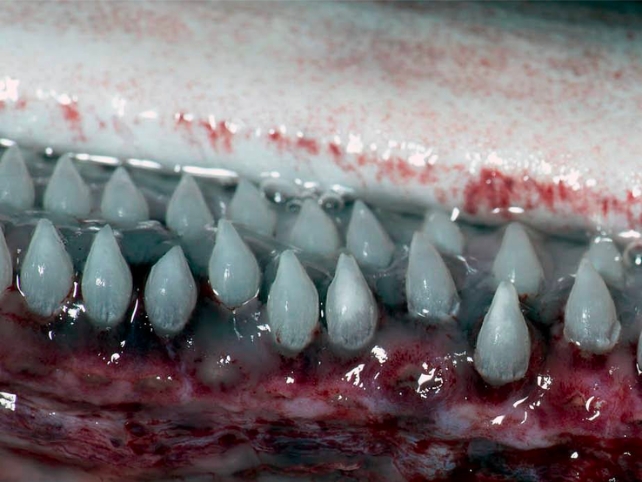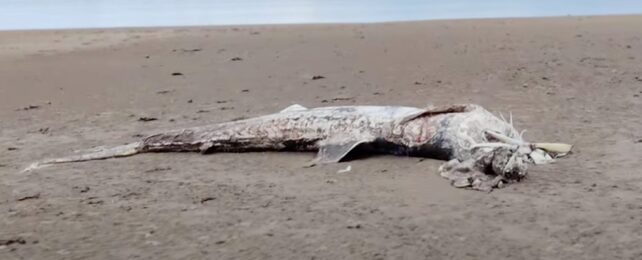On January 5, the remains of a massive creature washed up on a sandbank were spotted by 72-year-old New Brighton resident Stephen Davies, who was out for his morning exercise near the River Mersey at the mouth of Liverpool Bay in the UK.
In spite of locals referring to the New Brighton carcass as a 'giant alien' or even a 'New Brighton Nessie', Davies would soon learn he had stumbled upon the body of a 15-foot (about 4.6 meters) long basking shark (Cetorhinus maximus).
"I was running on the beach and thought 'what's that?' because it looked quite big," Davies told Wesley Holmes at the Liverpool Echo.
"I was talking to a fisherman who said it was a basking shark, which I don't think are fairly common around here, but it could have been washed in by the tide. I have never come across anything like it before."
Remains of enormous creature wash up on Merseyside beachhttps://t.co/6ntuFppmkf
— Liverpool Echo (@LivEchonews) January 6, 2024
Reaching a maximum weight of 6 metric tons and length of 12 meters (39 feet), the basking shark is one of the largest fish on Earth, beaten only by the whale shark (Rhincodon typus).
A reputation for 'basking' in warmer surface waters near the shore with its mouth wide open inspired its common name. Their genus name is far less serene, derived in part from the Greek term for "marine monster."
Throughout history, basking sharks have been associated with fearsome beasts due to their large size and unique feeding habits. Ancient sailors feared these colossal sea monsters were exactly that; their massive size alone was enough to fuel speculation about monstrous creatures lurking beneath the waves. Tales of sea serpents have originated from observations of the filter-feeding sharks swimming in a single-file formation near the water's surface.
However, these gentle giants are no fearsome predator. They typically move slowly, scooping up tiny zooplankton in their enormous mouths that can be up to a meter wide.
Despite its slowness, a 2018 study found that comparable to great white sharks, this mammoth fish can breach completely out of the water at staggering speeds of about 5 meters per second.
While great white sharks (Carcharodon carcharias) are known for their rapid breaches during surface hunting for prey, filter-feeding basking sharks don't require such maneuvers for feeding. Researchers think they may be engaging in acrobatics to eliminate parasites, deter predators, or possibly attract mates.

Despite its impressive size, the body found on Friday is thought to be of a youngster at barely half the maximum length for its species. British Divers Marine Life Rescue (BDMLR) North-West co-ordinator, Chris Cureton, confirmed the animal's identity upon inspection at the scene.
"The dead giveaway was its second dorsal fin, the head is pretty decomposed but there is no sign of a recognisable toothed shark jaw," Cureton told Rebecca McGrath at the Wirral Globe.
"The tail of the animal is full of bones whereas if it was a whale it would have been flesh."
The elusive basking shark, typically seen during the summer months along the coasts of southwest England, Wales, the Isle of Man, and west Scotland, remains somewhat of a mystery, with many aspects of its lifestyle yet to be studied. Scientists only recently discovered they represent a rare case of a partially warm-blooded fish.
Satellite tracking has revealed migration over long distances in winter, with some appearing off the Azores volcanic islands and Newfoundland. Some fishermen report still seeing them in the UK during midwinter, and occasionally they wash up dead after winter storms.
"I've personally never seen one wash up on the banks of the Mersey before," Cureton said.
"It might not have died near the Mersey but it might be something to do with the storms we've had which may have brought it in."

Basking sharks are listed as Endangered on the IUCN Red List due to threats from overfishing and accidental entanglement in fishing gear.
Commercial fishing equipment can sometimes bring their decaying carcasses to the surface, or they can wash up on shore. The basking shark's relatively small skull in comparison to its elongated body often leads people to believe the carcasses are those of some unknown beast.
Their distinct features decompose in ways that further distort their appearance and can contribute to misinterpretation and mystery. Decomposing typically starts with the lower head area, and the dorsal and caudal fins, creating a resemblance to a plesiosaur.
Their historical misidentification includes instances like the 1977 discovery of a creature resembling a plesiosaur or prehistoric 'sea-monster' off the Christchurch coast, and the 1808 'Stronsay Beast' in Scotland, initially thought to be a sea serpent.
The thought of an intriguing mystery is often more enticing than the truth, a trend that continues even today.
